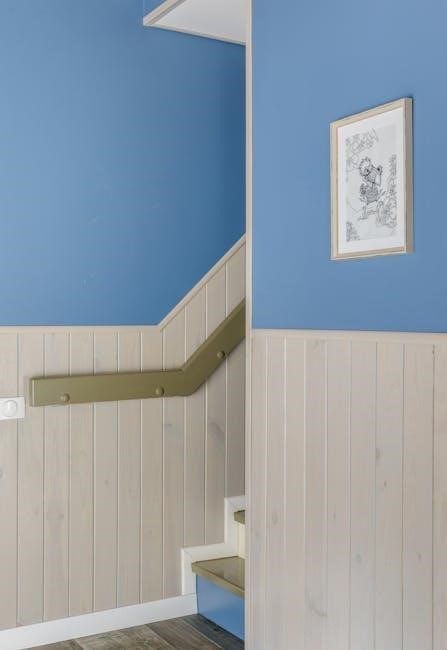Face painting is a vibrant and creative art form that transforms faces into colorful canvases, offering endless possibilities for self-expression and joy in various celebrations and events.
1.1 What is Face Painting?
Face painting is a dynamic art form that involves applying paint or makeup to transform a person’s face into a creative design. Using specialized paints and brushes, it allows individuals to express their imagination through vibrant, temporary designs. This practice is popular at events, parties, and festivals, offering a fun way to celebrate and embrace self-expression. It suits all skill levels, from simple designs to intricate masterpieces, making it accessible to everyone interested in exploring their artistic side.
1.2 Benefits of Face Painting for Beginners
Face painting offers numerous benefits for beginners, fostering creativity and self-expression while building confidence. It provides a fun, artistic outlet and a relaxing activity. Beginners can learn basic techniques quickly, making it accessible for all skill levels. Face painting also encourages social interaction and can be a rewarding way to bring joy to others at events or gatherings, sparking imagination and creativity.
Essential Supplies for Face Painting
Face painting requires a variety of tools, including high-quality brushes, sponges, face paints, and mirrors, to create vibrant and detailed designs with ease and precision.
2.1 Brushes and Sponges
High-quality brushes and sponges are essential for face painting. Brushes with natural fibers are ideal for blending and fine details, while synthetic brushes work well for bold strokes. Sponges are perfect for applying base layers and creating textured effects. Using multiple brush sizes and sponge types allows for versatility in achieving various designs and details efficiently.
2.2 Face Paints and Their Types
Face paints come in various types, including water-based, cake, and metallic. Water-based paints are easiest to apply and remove, while cake paints require water activation. Metallic paints add shimmering effects. Choose hypoallergenic, non-toxic options for safety. Using high-quality paints ensures vibrant colors and smooth application, enhancing the overall face painting experience for both artists and wearers.
2.3 Mirrors and Other Tools
A plastic mirror is ideal for face painting, as it’s durable and safe for children. Other essential tools include sponges for base colors, detail brushes for fine lines, and applicators for specific effects. These tools help create smooth, even coverage and intricate designs, making the face painting process efficient and enjoyable for both beginners and professionals.
Preparation for Face Painting
Preparation involves cleaning the face thoroughly and applying thin, even base layers. Use water to dilute paints and ensure each layer dries before adding more details.
3.1 Cleaning and Hygiene
Proper cleaning and hygiene are crucial for safe face painting. Always wash hands and sanitize tools before starting. Ensure the face is clean and dry, removing dirt or oils. Use hypoallergenic products to minimize skin sensitivity. Clean brushes with mild soap and water after each use to prevent bacteria buildup. Hygiene ensures a safe and enjoyable experience for everyone involved.
3.2 Applying Base Layers
Applying base layers is essential for a smooth finish. Use thinned face paint and apply in light, even strokes. Allow each layer to dry completely before adding more. Start with neutral tones to cover the skin evenly, ensuring a solid foundation for detailed designs. This step ensures vibrant colors and prevents peeling, creating a professional finish for your face painting artistry.

Basic Face Painting Techniques
Mastering basic techniques involves layering, blending, and detailing. Start with thinned colors for smooth base layers, then use stamping or stencils for patterns, and blend for seamless transitions, creating vibrant, professional designs with ease and precision in your face painting journey.
4.1 Stamping and Stencils
Stamping and stencils are excellent tools for creating intricate designs without advanced skills. Use pre-made stencils for patterns like superhero logos or animal shapes. Stamping tools, such as sponges or specialized stamps, add textures and details quickly. These methods are perfect for beginners, allowing you to achieve professional-looking results with minimal effort, making your face painting process fun and efficient for all skill levels.
4.2 Blending Colors
Blending colors is a key technique in face painting that creates smooth transitions and depth. Use thinned paints or layering to merge colors seamlessly. Sponges and brushes are ideal tools for blending. Apply light layers and allow them to dry before adding more color to avoid muddying the design. This method enhances realism and artistic effects, making your designs stand out beautifully.
4.3 Creating Simple Designs
Start with basic shapes like circles, lines, and dots to create simple yet impressive designs. Use stencils for precision or freehand for a more personal touch. Begin with a base color, then add details gradually. Themed designs, such as superheroes or animals, are great for beginners. Practice layering and blending to enhance your creations, ensuring each step is neat and deliberate for a polished look.
Advanced Face Painting Techniques
Master advanced techniques like layering, 3D effects, and contouring to create stunning, professional-looking designs. Use thin layers of paint and patience to achieve intricate details and depth.
5.1 Layering and Details
Advanced face painting involves mastering layering techniques to achieve depth and dimension. Apply thin layers of paint, allowing each to dry before adding the next. Use fine brushes to add intricate details, such as textures, patterns, or small features. This step-by-step process enhances the design, creating a polished and professional finish. Practice patience and precision to perfect these skills.
5.2 3D Effects and Contouring
Creating 3D effects and contouring in face painting involves using shading techniques to add depth and dimension. Apply darker shades to recessed areas and lighter tones for highlights. Use fine brushes for details and sponges for blending. Practice these techniques on various face shapes to master realistic, three-dimensional designs that captivate the eye.

Themed Face Painting Designs
Themed face painting designs bring creativity to life, offering endless options for events. Popular themes include superheroes, animals, and nature-inspired looks, allowing faces to transform into vibrant characters or elements that match any occasion, making them a favorite for celebrations and self-expression.
6.1 Superheroes and Cartoon Characters
Superheroes and cartoon characters are beloved face painting themes, offering vibrant, recognizable designs. From Spider-Man to princesses, these looks are achieved with bold lines and bright colors. Simple steps include outlining the character’s features, filling in colors, and adding details like masks or capes. These designs are perfect for kids’ parties and celebrations, bringing joy and transforming faces into iconic figures instantly.
6.2 Animals and Nature-Inspired Designs
Animal and nature-inspired designs bring the wild to life on faces, offering a wide range of creative options. Popular choices include tigers, butterflies, and cats, with steps involving outlining shapes, adding fur textures, and detailing eyes or whiskers. Earthy tones and blending techniques create realistic effects, while floral patterns and leaf designs add a natural, whimsical touch for any occasion.
Safety and Hygiene Practices
Ensure clean brushes and tools by washing with mild soap and water after use. Always test paints for allergies and use hypoallergenic products for sensitive skin.
7.1 Allergies and Skin Sensitivity
Always test face paints on a small area of skin before application to check for allergic reactions. Use hypoallergenic, non-toxic products to minimize the risk of irritation. Avoid products containing harsh chemicals or heavy metals. Ensure paints are FDA-compliant for cosmetic use. If a reaction occurs, remove the paint immediately and consult medical advice if necessary.
7.2 Cleaning Brushes and Tools
Regularly clean face painting brushes with mild soap and warm water to remove paint residue. Sanitize tools with alcohol to prevent bacteria growth. Use a soft cloth to wipe sponges and mirrors. Properly rinse and reshape brushes before storing to maintain their quality and ensure longevity. Cleanliness is essential for safe and professional face painting practices.

Practice and Improvement Tips
Consistent practice is key to mastering face painting. Use water to thin paints and apply thin layers, letting each dry before adding more. A plastic mirror is ideal for safe, easy makeup application.
8.1 Setting Up a Practice Routine
Establish a structured practice routine to enhance your face painting skills. Dedicate 15-30 minutes daily or a few hours weekly. Start with simple exercises like basic strokes and color blending. Use a mirror to observe your technique and track progress. Focus on mastering one design at a time. Adjust your routine as your skills improve.
8.2 Learning from Online Tutorials
Online tutorials offer step-by-step guidance, perfect for mastering face painting techniques. Platforms like YouTube and Pinterest provide easy-to-follow videos and guides. Expert artists share tips for creating detailed designs, from superheroes to princesses. These resources help you learn at your own pace and gain confidence in your skills. Practice designs like Spider-Man or floral patterns to improve quickly and professionally.

Professional Face Painting Tips
Mastering time management and building a portfolio are key to success. Learn to work efficiently during events and showcase your best designs to attract clients.
9.1 Time Management for Events
Effective time management is crucial for professional face painters during events. Plan designs in advance, organize supplies, and estimate time per design. Keep a steady pace to accommodate queues without compromising quality. Prioritize simpler designs for quick turnaround and more intricate ones during slower periods. This ensures efficiency and satisfaction for both you and your clients.
9.2 Building a Portfolio
Creating a portfolio is essential for showcasing your face painting skills. Include high-quality images of your best designs, demonstrating versatility and creativity. Organize your work by themes, such as superheroes or animals, and highlight step-by-step tutorials. Use good lighting and editing to ensure clarity. Share your portfolio on social media or websites to attract clients and grow your reputation as a professional face painter.
Cultural and Artistic Considerations
Face painting connects cultural traditions with modern artistic expression, blending traditional styles and contemporary trends to create unique designs, inspiring artists to explore diverse techniques and themes.
10.1 Traditional Face Painting Styles
Traditional face painting styles are deeply rooted in cultural heritage, often using natural materials like earth pigments and plant dyes. Techniques passed down through generations emphasize symbolic patterns and tribal designs. For instance, African tribal face painting features bold geometric shapes, while Japanese Kabuki styles showcase dramatic, expressive motifs. These traditional methods continue to inspire modern face painting artists, blending history with contemporary creativity.
10.2 Modern Artistic Trends
Modern face painting trends emphasize creativity and innovation, blending traditional techniques with contemporary styles. Artists now experiment with 3D effects, metallic paints, and abstract designs. Inspired by pop culture, trends include galaxy-themed faces, glow-in-the-dark effects, and intricate details. Social media platforms showcase these dynamic styles, encouraging artists to push boundaries and innovate, making face painting a constantly evolving art form.
Mastering face painting requires patience and practice. Start with simple designs, gradually experimenting with advanced techniques. Embrace creativity, stay inspired, and enjoy the artistic journey.
11.1 Final Tips for Success
To excel in face painting, practice regularly and experiment with new techniques. Use thin layers of paint, allowing each to dry before adding details. Blend colors smoothly and stay organized with supplies. Keep inspiration handy and maintain patience with each design. Embrace creativity and enjoy the process of transforming faces into vibrant works of art.
Additional Resources
Explore Pinterest boards like Face Painting 101 for step-by-step designs. Check out recommended books and online tutorials for advanced techniques and inspiration to enhance your skills.
12.1 Recommended Books and Tutorials
Discover step-by-step guides on Pinterest boards like Face Painting 101, offering designs for holidays and characters. Books provide detailed instructions with colorful illustrations, while online tutorials, such as the Spider-Man face paint guide, share expert tips. These resources help beginners and professionals master techniques, from base layers to intricate details, ensuring a polished finish every time.
12.2 Joining Face Painting Communities
Engaging with face painting communities offers invaluable learning opportunities. Platforms like Pinterest and specialized forums connect enthusiasts, sharing ideas and inspiration. Interacting with experts and fellow artists fosters creativity and skill improvement. These communities provide access to tutorials, tips, and resources, helping you stay updated on trends and refine your techniques effectively.
